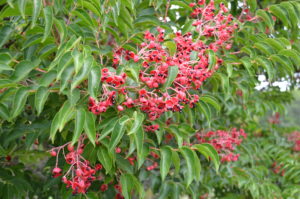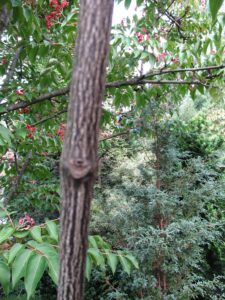The late Dr. J. C. Raulston, N.C. State University horticulture professor emeritus, discovered Korean sweetheart tree (Euscaphis japonica) in 1985 on the Korean Peninsula while participating in a U.S. National Arboretum collection expedition (USDA hardiness zones 6-8). Dr. Raulston brought seeds back to the N.C. State Arboretum for assessment and evaluation. The species common name “sweetheart tree” was coined by Tennessee nurseryman Mr. Don Shadow.
Small 9-inch long terminal panicles of yellow flowers appear in late spring, most hidden within the dense foliage and go mostly unseen. Opposite pinnately compound leaves are 6-10 inches long. The compound leaves are comprised of dark green, 2-4 inch long leaflets. The tree’s greatest asset is the showy bountiful clusters of heart-shaped fruit capsules. They gradually ripen from green to pink to finally red in late summer. In early to mid-October the fruit capsules split apart to reveal a tiny, shiny, black seed within. The grayish colored bark has white striations which provide some winter interest.
Sweetheart tree prefers a good loamy well-drained soil and planted in full sun to partial shade. Feed annually with a slow-release fertilizer such as Osmocote® or Nutricote®. Although an older established tree is highly drought tolerant, provide supplemental irrigation to a new 1-3 year old tree if summer rainfall is sparse.
No serious disease and insect problems trouble this small 2o-25 feet tall tree. In the early years corrective pruning is recommended for shaping the young tree. Availability is primarily from on-line plant nurseries.



 Posted in
Posted in 
